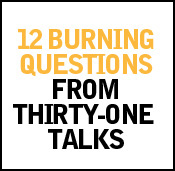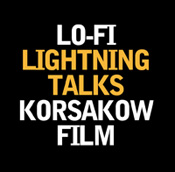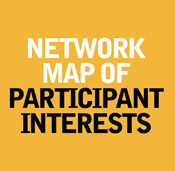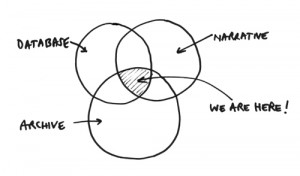First, apologies for this delay. This was supposed to be a “live” blog. Second, congratulations to everyone involved – especially to all the members at CINER-G and for Matt Soar and Monika Kin Gagnon, co-organizers extraordinaire – but also to all the presenters, attendees and volunteers. Everyone’s efforts made this an incredibly memorable academic event. We all know there aren’t many events dealing with the intersections between database, archive, narrative and non-linearity in storytelling and this was surely a great one. Let’s not make it long between now and the next event. But until then, perhaps I can offer a few thoughts of reflection. Please note, these are purely antagonistic. They are not meant as judgments but rather as invitations for further exploration and as provocations for further discussion.
There was something strange going on in the symposium. Somewhat along the lines of what Sandy Carson pointed out as a theoretical short-sighting or lack of critical language existing to describe (or work through) the audience/user/spectator/browser. Puzzling was the choice of words used to describe the projects presented and discussed. Particularly interesting was the number of times database projects were referred to as “films.” The fact is, aside from Phil Hoffman’s piece, none of the projects presented at the symposium were films – as in, celluloid – but were instead made up of digital or electronic technologies. Conversely, the other term that was floating around was ‘DNA projects.’ As fitting as this term may sound, I don’t see it sticking throughout an internationally conducted dialogue. Certainly not any more than the term film would.
I am not proposing that the term film cannot evolve to include other types of media forms. I firmly believe this is a normal aspect of language and of media development. I simply want to raise concern and bring attention to the consensus that was evident throughout the symposium, and ask: why film and why not cinema, moving-images, motion-pictures, or movies? Is it because films stand in for a higher quality of moving-image projects, whereas movies stand in for a lower one, as in, by calling these “films” we raise their cultural value? Or is it because motion-pictures is reserved solely for celluloid? If this is the case, then why is film so easily transferable while motion-picture is not? Or is there a thinking-through process, involved in making these projects, that aligns them with celluloid usage and the use of this as a reference point to other techniques of moviemaking as predecessors? And if so, is the aim to maintain a relationship with celluloid and to define it as the parent of moving-image media? And if this is the case, does this then construct the history of these projects as a struggle against a dominant yet loving figure of mass-media format, setting up film as a mass-media and database projects as unmassed-media, thereby reanimating Andreas Huyssen’s “great divide,” separating mass-culture on the one side and avant-garde culture on the other?
If either of these reasons has some validity to them, then I would argue, following the spirit of database projects to rethink linearity, what we need is a different vocabulary, one that does not correspond so closely with other media types, and one that does not think of a linearity or hierarchy between media and social types; if only because some of the very aims, and (arguably) driving rational, behind many of these projects include the removal of hierarchical social structures, the “surrendering” of power, and the representation of non static cultural forms.
For example, instead of aligning these projects with the high-brow equivalent of cinema, why not align them with cinema’s low-brow equivalent? What is the need to situate these projects in culture’s higher end of the spectrum? Why not situate them in culture’s low or middle grounds? For example, if the term movies is slang for moving-images, why not create a slang equivalent to database projects and call them databasies? I know. It is a little strange to say “I am watching a databasie.” But isn’t this exactly what every practitioner who presented at the symposium is trying to accomplish – to get people to watch a database? Well perhaps not. Clearly not everyone thinks of these projects as necessarily being “watched,” but rather as browsed, experienced, or as Monika Wermuth thinks, as being strolled through in much the same way that a city is.
Not to abruptly stop, but is anyone up for a stroll through a databasie? Maybe we can continue this conversation while glancing at other ideas?





Good points, except near the end, we don’t watch a databasie, we need a specific term there too. But they’re not films, they’re not movies. Many are what we would have once been happy to call non fiction multimedia. Still not sure why they still aren’t non fiction multimedia. But hey, I don’t even think they’re much about databases either, so for my money perhaps non fiction multimedia and programmatic non fiction?
I am not sure everyone agrees they are working on non-fiction projects. Arguably most of the work is fiction based.
The same is true with multimedia. There are a lot of projects that are not made up of a number of different media. Also, I find the term to not only be dated but also to be porous. It can mean a lot of things and does not necessarily refer to all that is implied.
I agree with you that “databasie” is a term that should not see the light of day (maybe it can see the dark of night?). But, what are the reservations about database? How are these projects not “about databases”?
The search is still on.
Point 100% taken Zach, but:
- Yes they are “databased” but they are not a data base, only!
They are narratives, stories, maps, meta-media, transmedia, multi-genre plots, etc . They use GUI or TUI but they focus their UX in the aesthetic experience of the content. They are not a back-office for on-line banking…
Sometime ago in a paper from the Media Lab Europe (WOOD, A., DAVENPORT, G., DONOVAN, B., AND STROHECKER, C. Stories for remote place: content, structure, device, trials. Archives & Museum Informatics, 2004, p. 2.) gave it a shot to defined this kind of content and experience in its point “4. Story: Experience, Structure, and Style”[Wood et al., 2004] :
“It is not easy to craft a narrative set of physically distributed fictional scenes which are to change according to a chaotic environment and are to be navigated in varied, unpredictable orders. Scene delivery must be guided by a meta-experience that provides overall coherence to the viewing of media in the space. Within a particular scene, certain features must be built-in to the narration so that every segment is guaranteed to both match audience environment and make sense given what has been heard already. These principles require three design tasks: defining an overall story experience, articulating a structure to technically enforce that experience, and developing a style to express context, theme, and plot.” [Wood et al., 2004]
This said, and we can find other frameworks that are probably as much as this, I don’t have any card up in my sleeve to come with a word/concept for the name of the “Rose” but I suspect it will be a non-linear, collaborative building-up process!
And It Already Started HERE!
Keep Posting!
By the way, why not a KISS approach? DataStory/DataStories? No?
Comments on this entry are closed.